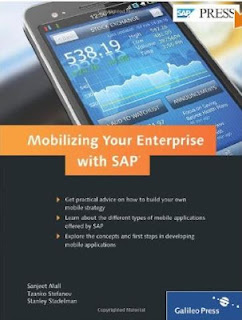ABAP learning
made easy, without any prior knowledge! This introductory book covers all the
relevant ABAP language elements in compact and concise learning units. On the
basis of a consistent practice example you build from the first page your own
programming solutions. Numerous examples and useful tips and tricks are the
guarantor for your progress, so you will soon celebrate its first successes
with self-written source code.
This 3rd Edition
is based on ABAP 7.0 EHP2 and contains classic ABAP techniques also information
on related topics such as Web Dynpro, enhancement packages, Enterprise
Services, etc.
From the
contents:
- Data Dictionary and ABAP Editor
- Fields and calculations
- Modification of strings and string operations
- Reckon with time and date, amounts and currencies
- Transparent database tables and internal tables
- Program Flow and Logical Expressions
- Selection Screens
- Debugging and modularization of programs
- Reports automatically start
- Advanced Topics
Press
"Discover
ABAP" is a solid beginner’s guide to the first contact with the
programming dinosaur. Training covers the basic functions, allowing the reader
to understand after reading the book ABAP code and can write your own code.
Programming skills in another language, although an advantage but not a must.
Some rethinking would be necessary anyway in specific aspects. Try it suitable
for fast ABAP not. This text refers to an out of print or unavailable
edition of this title.
About the Author
Karl-Heinz Kuhnhauser
worked according to the doctrine as an industrial clerk and studying Economics
and Statistics as a freelancer in the field of software development and system
architectures, initially in the field of mainframes, later in the SAP area. He
was managing partner of RGS GmbH & Co. KG, an SAP services partner. His
knowledge of over 1,000 training days he passed as a lecturer for SAP
application development and human resource management at the University of Applied
Sciences Ansbach and a member of the working
group and instructor of the Audit Committee of the Chamber of Commerce. He had
project experience from numerous customer projects and industry experience in
the areas of trade, banking and insurance, to government service. Karl-Heinz Kuhnhauser
died unexpectedly in July 2009.
Thorsten Franz
is SAP mentor and software architect at AOK Systems GmbH For more than ten
years, he worked as a developer, architect, consultant and project manager in
ABAP development projects. The focus is on the creation of large SAP
applications and SAP-based industry solutions. His special attention to the
creation of future-oriented application and enterprise architectures based on
SAP NetWeaver and the opportunities to use them for new applications. In his
previous projects, he worked with a broad cross-section of SAP applications and
technologies, from the classics of the SAP Business Suite to cloud-based,
mobile and in-memory solutions. Thorsten Franz is a regular speaker at
international developer conferences.

.jpg)

